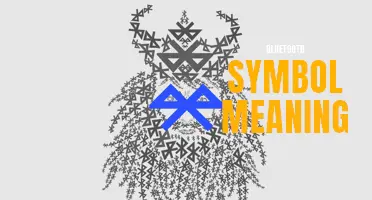
Predators have always captured our imagination, evoking a mix of fear, awe, and curiosity. They symbolize power, stealth, and the primal instincts that lie within all of us. From lions and eagles to sharks and wolves, predators embody the essence of the wilderness and remind us of the delicate balance between life and death in nature. Beyond their natural prowess, these apex creatures have also become symbols in various cultures and mythologies, representing traits such as survival, leadership, and even spiritual strength. In this article, we will explore the fascinating world of predator symbol meaning and discover the rich symbolism behind these magnificent animals.
What You'll Learn
- What is the meaning behind the predator symbol and how did it originate?
- Are there different interpretations or variations of the predator symbol in different cultures or communities?
- Does the predator symbol have any historical or mythological significance?
- How is the predator symbol used in contemporary society and popular culture?
- Are there any specific groups or organizations that use the predator symbol as their emblem or logo?

What is the meaning behind the predator symbol and how did it originate?
The predator symbol is a widely recognized emblem that represents strength, power, and agility. It is prominently featured in the logo of popular brands and sports teams, and has become synonymous with a competitive and aggressive nature. The symbol's origin can be traced back to ancient civilizations, where various cultures revered predators as symbols of courage and leadership.
One of the earliest depictions of predators as powerful symbols can be found in ancient Egyptian art. Lions, known for their strength and ferocity, were commonly depicted in tombs and temples to represent the pharaoh's power and protection. Egyptians believed that the lion's characteristics, such as fearlessness and dominance, could be bestowed upon the ruling leaders.
Similarly, in ancient Greek mythology, the predator symbolized strength and skill. The goddess Athena, known for her wisdom and strategic prowess, was often depicted with an owl, a nocturnal predator associated with vigilance and sharp senses. The Greeks admired the predator's ability to hunt and survive in the wild, considering these qualities to be essential in both warfare and leadership.
In Native American cultures, predators like the wolf and the eagle held significant spiritual symbolism. The wolf was seen as a symbol of loyalty, teamwork, and resilience, while the eagle was revered for its keen eyesight and ability to soar high above the ground, representing foresight and vision. Native American warriors would often adorn themselves with predator symbols to invoke the spirits of these animals and harness their attributes during battles.
The modern interpretation of the predator symbol has evolved over time. In contemporary culture, it is often associated with sports teams and brands that embody a competitive spirit. The symbol's aggressive and assertive nature aligns with the values of teamwork, determination, and success. It has been adopted by various sports teams around the world, such as the NFL's Carolina Panthers and the NHL's Nashville Predators, who aim to convey strength and dominance on the field of play.
The predator symbol has also found its way into popular media and entertainment. It is prominently featured in movies, video games, and clothing brands that cater to the thrill-seeking and assertive individuals. The symbol's allure lies in its ability to convey a sense of power and confidence, appealing to those who strive to be in control and excel in their pursuits.
In conclusion, the predator symbol carries a rich history and symbolism that dates back to ancient civilizations. It represents strength, power, and agility, and has been revered by various cultures as a symbol of leadership and courage. In modern times, the symbol has become popular in sports and popular culture, embodying the competitive and aggressive nature that is admired and sought after by many.
Unveiling the Spiritual Meaning and Symbolism of Palm Trees: Connecting Earth and Spirit
You may want to see also

Are there different interpretations or variations of the predator symbol in different cultures or communities?
Symbols hold significant meaning in cultures and communities around the world. They often represent ideas, beliefs, and values that are deeply ingrained in a particular group of people. One symbol that has gained recognition globally is the predator symbol. Known for its powerful representation of strength, dominance, and survival, the predator symbol can be found in various forms and interpretations in different cultures.
In ancient civilizations, such as the Egyptians and Greeks, the predator symbol was often associated with gods and goddesses. In Egyptian mythology, the lion was considered a symbol of protection and represented the goddess Sekhmet, who was known as the lioness-headed goddess of war. Similarly, in Greek mythology, the lion symbolized power and was closely linked to the goddess Hera, who was the queen of the gods.
In Native American cultures, the predator symbol holds multiple interpretations based on the specific animal represented. For example, the wolf is often seen as a sacred animal that embodies strength, loyalty, and protection. Native American tribes, such as the Cheyenne and Pawnee, associate the wolf with bravery and the ability to navigate through difficult situations. On the other hand, the cougar is seen as a symbol of leadership, agility, and adaptability. It represents the ability to overcome challenges and emerge victorious.
In modern popular culture, the predator symbol has evolved to represent a broader range of ideas and concepts. It is often associated with sports teams, such as the Minnesota Vikings or the Carolina Panthers, who use predator animals as mascots to represent their strength and competitiveness. Additionally, the predator symbol has been embraced by various subcultures and communities, including gamers and outdoor enthusiasts, who see it as a symbol of resilience and survival in challenging environments.
It is important to note that the interpretations and variations of the predator symbol may differ significantly across cultures and communities. The meaning attributed to this symbol is subjective and can change depending on the context in which it is used. While some may see the predator symbol as a representation of power and dominance, others may associate it with a sense of protection and survival instincts.
In conclusion, the predator symbol holds different interpretations and variations in different cultures and communities. From ancient civilizations to modern subcultures, this symbol has been used to represent strength, dominance, and survival. Whether associated with gods and goddesses, Native American beliefs, or popular sports teams, the predator symbol continues to hold a significant place in our global society.
Demystifying the Circle with Arrow Symbol: What Does it Mean?
You may want to see also

Does the predator symbol have any historical or mythological significance?
The predator symbol, also known as the predator's mark or the predator's symbol, is a distinctive emblem that has been associated with various historical and mythological figures throughout history. This symbol has often been connected with strength, power, and dominance.
In ancient mythologies, predators such as lions, wolves, and eagles were often depicted as symbols of courage, nobility, and leadership. These animals were revered for their hunting prowess and seen as embodiments of divine strength. Consequently, the predator symbol began to represent these desirable qualities.
In ancient Egyptian mythology, for example, the lion was closely associated with the gods and goddesses. The goddess Sekhmet, often depicted with the head of a lioness, was a fierce warrior and protector. The lioness symbolized her power and ability to defend her people against any threats. The lioness symbol, therefore, became a representation of strength and protection in ancient Egypt.
Similarly, in Norse mythology, the wolf was an important symbol. Fenrir, the monstrous wolf offspring of Loki, was feared for his strength and brutality. The wolf symbolizes power and ferocity, as well as being connected to the concepts of loyalty and family.
In Native American cultures, the eagle has long been a symbol of power, vision, and freedom. It was believed that eagles possessed a connection to the spiritual realm and were messengers between the gods and humans. The eagle symbolizes strength, courage, and nobility - qualities sought after in both warriors and leaders.
The predator symbol has also been associated with historical figures who exemplified strength and dominance. For example, the predators' mark was used by Attila the Hun to symbolize his authority and power over his people. Attila was a fearsome warrior and conqueror, and his use of the predator symbol further enforced his reputation as a ruthless leader.
In modern times, the predator symbol is often associated with predatory behavior or a sense of danger. It is frequently used in the context of crime and criminal organizations, as well as in popular culture, such as the iconic "Predator" film franchise.
While the predator symbol has varied meanings across different cultures and contexts, it consistently represents strength, power, and dominance. Whether it is depicted as a lion, a wolf, an eagle, or in other forms, the predator symbol continues to captivate the imagination and evoke a sense of primal fear and respect.
Decoding the Power Button Symbol: What Does it Truly Mean?
You may want to see also

How is the predator symbol used in contemporary society and popular culture?
In contemporary society and popular culture, the predator symbol has taken on various meanings and uses. Originally derived from nature, where predators are seen as powerful and dominant creatures, the symbol has been adopted into various contexts to represent strength, aggression, and even violence.
One prominent use of the predator symbol in popular culture is in sports. Many sports teams and individuals choose to incorporate predator imagery into their logos and mascots, to symbolize their ferocity and competitive spirit. For example, the NHL team the Nashville Predators uses a saber-toothed tiger as their logo, representing their predatory nature on the ice. Similarly, professional fighters often adopt predator-inspired monikers or nicknames to amplify their intimidating presence in the ring.
In addition to sports, the predator symbol has been widely integrated into the fashion industry. Numerous clothing brands and designers incorporate images of fierce animals such as wolves, lions, and tigers into their designs, portraying a sense of power and confidence. This trend can be seen in everything from T-shirts to high-end fashion collections, appealing to individuals who want to project a bold and daring image.
However, the predator symbol has also sparked controversy, especially in relation to gender. Some critics argue that the predator symbol perpetuates toxic masculinity and dangerous stereotypes. This is particularly evident in the representation of sexual predators in popular culture, where the symbol is often associated with individuals who exhibit predatory behavior towards others. This association can reinforce harmful beliefs and attitudes, contributing to a culture of violence and exploitation.
Another area where the predator symbol can be found is in the gaming industry. Many video games feature predatory creatures or characters as antagonists, emphasizing their cunning and predatory instincts. These characters often serve as formidable opponents for players to overcome, challenging them to strategize and outwit their virtual adversaries.
The predator symbol is also widely used in advertising and marketing, as companies leverage its connotations of power and dominance to sell products and services. Whether it's a car advertisement emphasizing speed and performance or a fragrance commercial showcasing seductive allure, the imagery of predators is often employed to elicit emotional responses and capture the attention of consumers.
It is important to note that while the predator symbol can be used in various contexts, its interpretation and impact vary greatly depending on the audience and cultural context. While some may find empowerment and inspiration in the symbolism of the predator, others may view it as offensive or harmful. As with any symbol, its meaning is subject to interpretation, and it is crucial to consider the potential implications and consequences of its usage.
The Ancient Hopi Symbols: Unveiling Their Meaning and Spiritual Significance
You may want to see also

Are there any specific groups or organizations that use the predator symbol as their emblem or logo?
The predator symbol, with its distinct features and fierce appearance, has caught the attention of various groups and organizations worldwide. While it is commonly associated with predators in the animal kingdom, it has also been adopted as an emblem or logo by several specific groups.
Sports Teams:
Many sports teams across different disciplines have chosen the predator symbol to represent their strength, agility, and competitive spirit. These teams often use the emblem on their jerseys, banners, and other promotional materials. The predator symbol can be seen among teams in sports such as football, rugby, basketball, and ice hockey, to name a few.
Military Units:
Several military units around the world utilize the predator symbol as part of their insignia or unit patch. This connection stems from the predator's attributes of stealth, power, and the ability to dominate its prey. Military units often adopt the predator symbol to represent their strength, skill, and ability to protect their country or achieve their objectives.
Law Enforcement Agencies:
Certain law enforcement agencies have also chosen the predator symbol as part of their logo or emblem. The connection between the predator symbol and law enforcement is based on the idea of predators in the animal kingdom hunting down and neutralizing threats, similar to the role of law enforcement in protecting society from criminals.
Outdoor and Survival Brands:
Outdoor and survival brands often use the predator symbol in their logos or marketing materials. This association signifies the brand's focus on adventure, survival skills, and a connection with nature. The predator symbol is seen as a representation of adaptability, resourcefulness, and the ability to conquer the challenges of the great outdoors.
Gaming and eSports:
In the world of gaming and eSports, the predator symbol is frequently utilized. Gaming brands, as well as individual professional gamers, often incorporate the emblem in their logos or as part of their overall branding. The predator symbol represents the competitive nature of gaming, strategy, and the hunt for victory in virtual realms.
It is important to note that while the predator symbol is widely used by these groups, its adoption does not necessarily imply support for aggressive or harmful behavior. Instead, it is often embraced for its symbolic representation of strength, prowess, and determination. Each group or organization may incorporate the symbol for their own specific reasons or to convey specific values or ideas that resonate with their mission or objectives.
Decoding the Samsung Dryer Display Symbols: What Do They Mean?
You may want to see also
Frequently asked questions
The predator symbol is often associated with power, dominance, and strength. It represents individuals who are skilled hunters, who are not afraid to go after what they want. In some cultures, the predator symbol also represents cunning and intelligence.
Some common predator symbols include the lion, eagle, wolf, and shark. These animals are often seen as apex predators in their respective habitats, and their symbolism is often associated with traits such as leadership, fierceness, and survival instincts.
While the predator symbol is generally associated with positive attributes such as strength and power, it can also have negative connotations depending on the context. The term "predator" itself often refers to someone who preys on others, taking advantage of their vulnerabilities. Therefore, in certain cases, the predator symbol can be seen as representing aggression, manipulation, or predatory behavior.
Yes, the interpretation of the predator symbol can vary across cultures. For example, in Native American cultures, the wolf is often seen as a spiritual guide and represents loyalty, intuition, and communication. On the other hand, in some African cultures, the lion is regarded as a symbol of royalty and power. These cultural variations highlight the different perspectives and meanings associated with the predator symbol.







